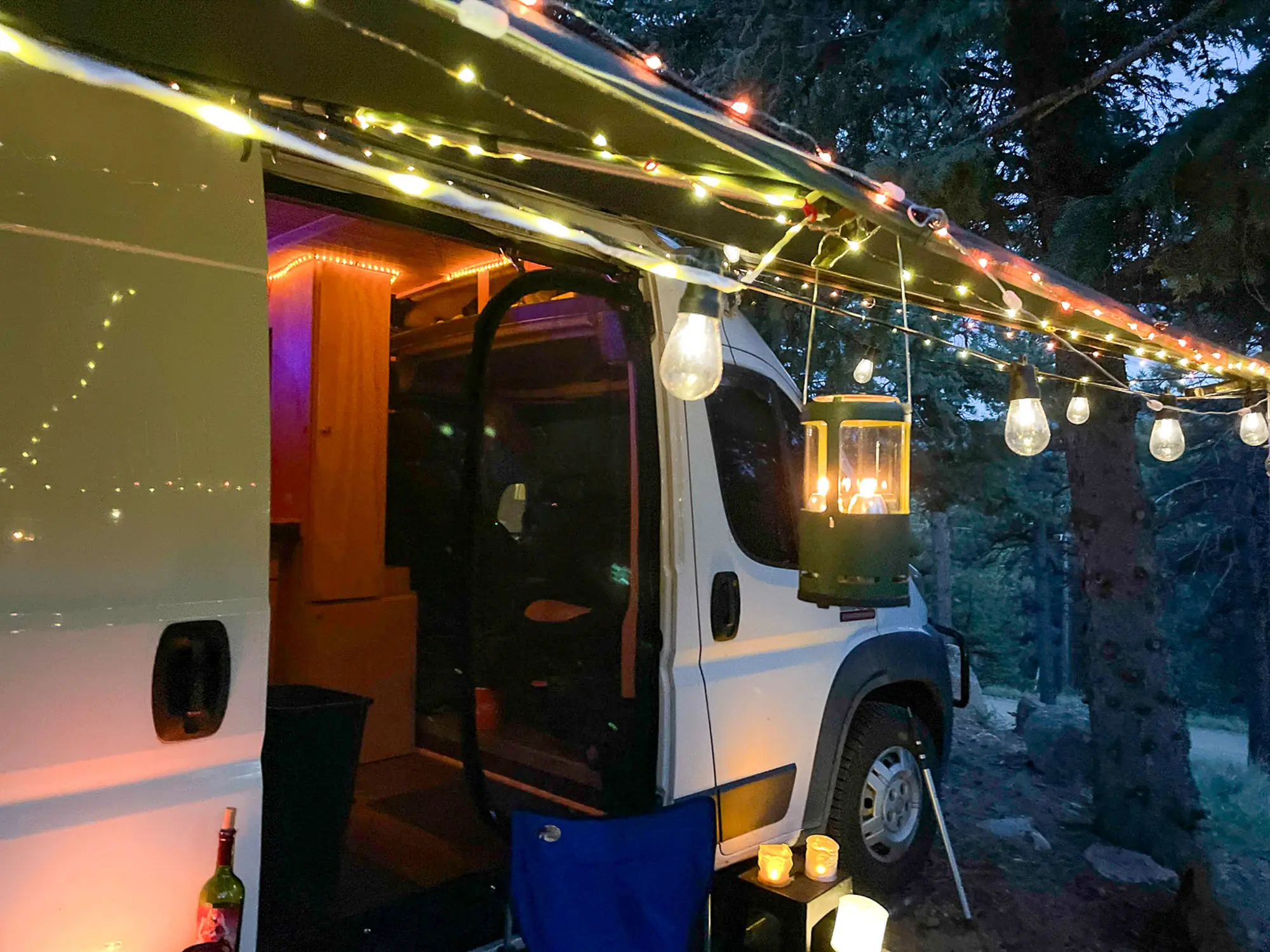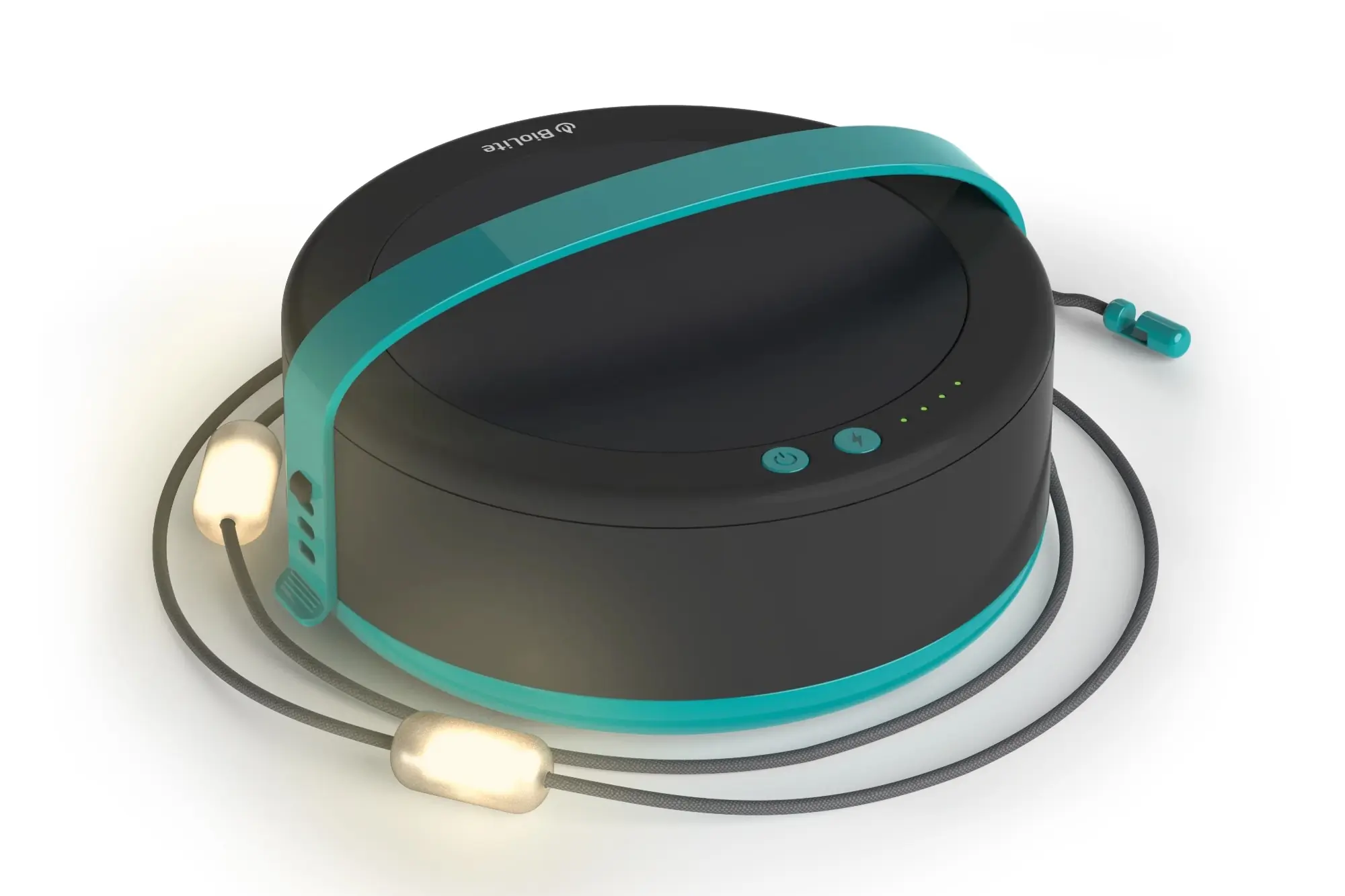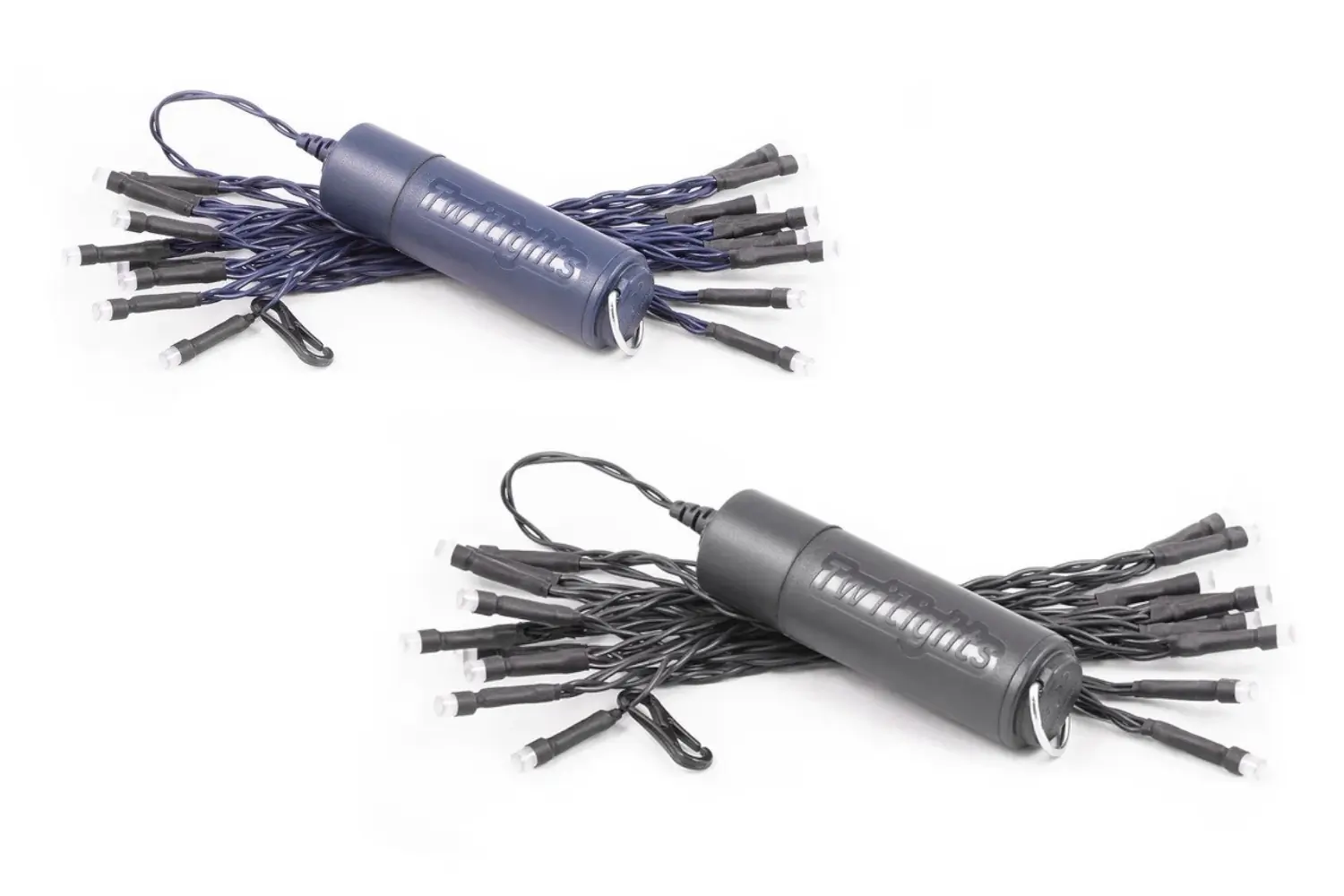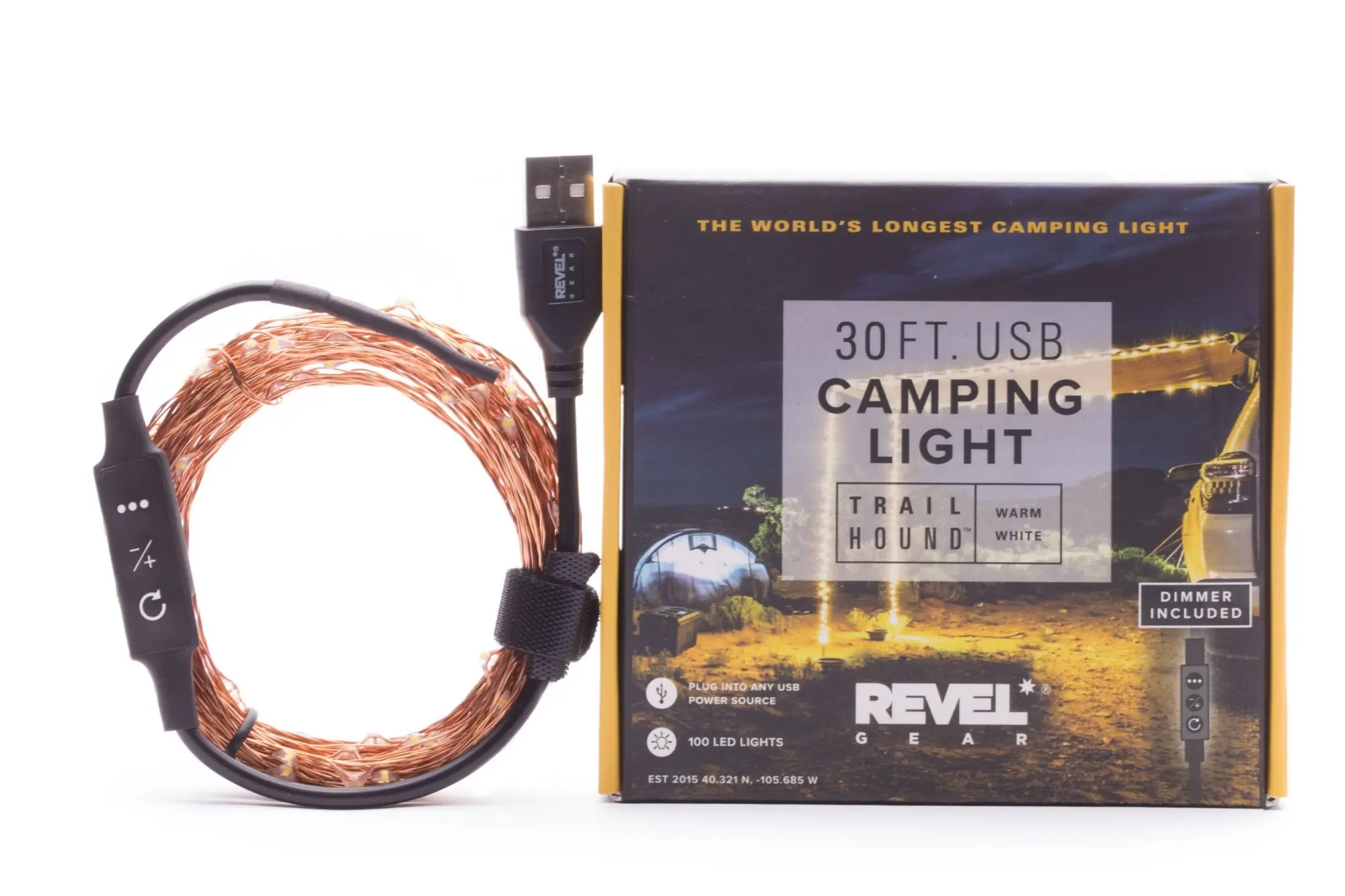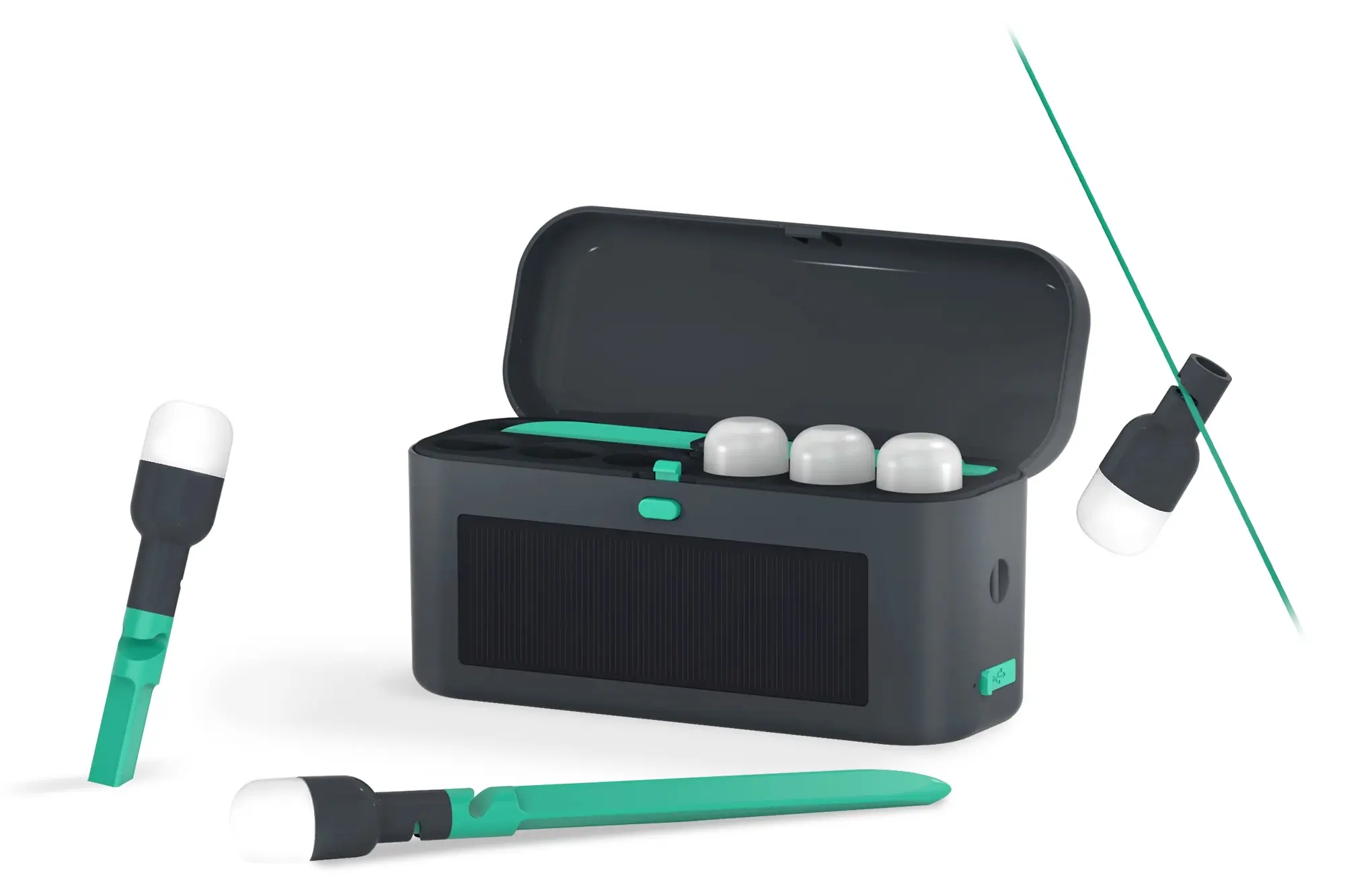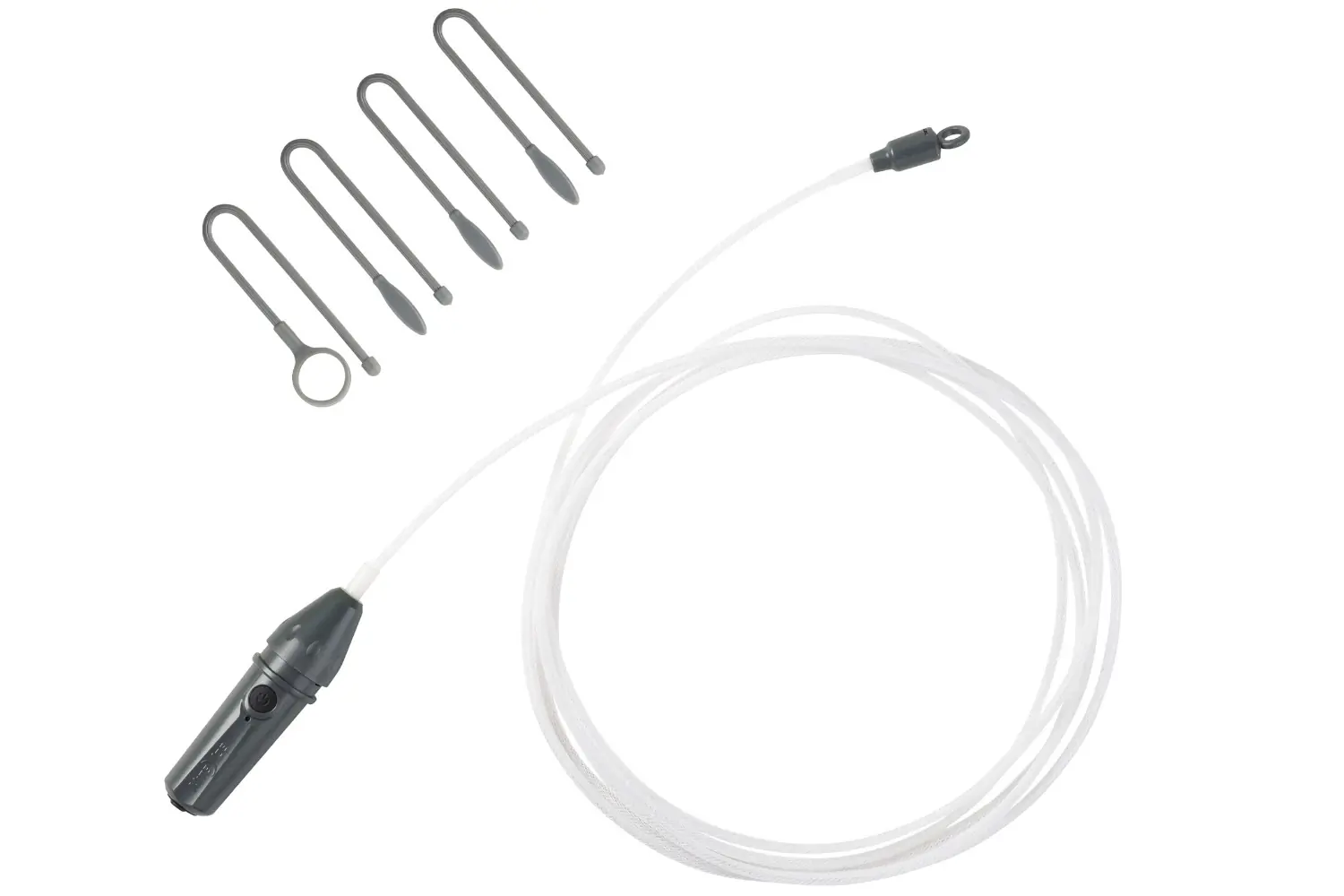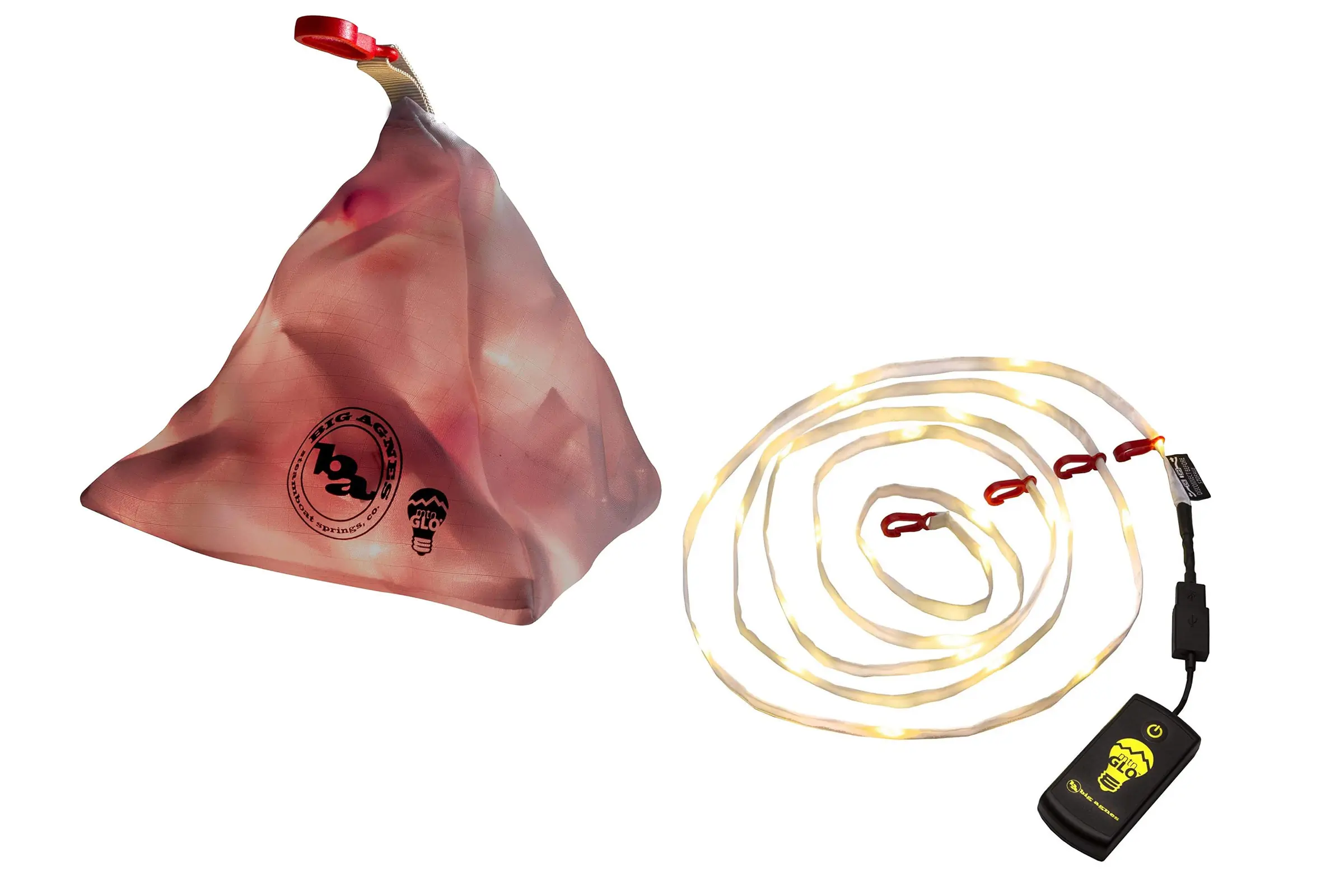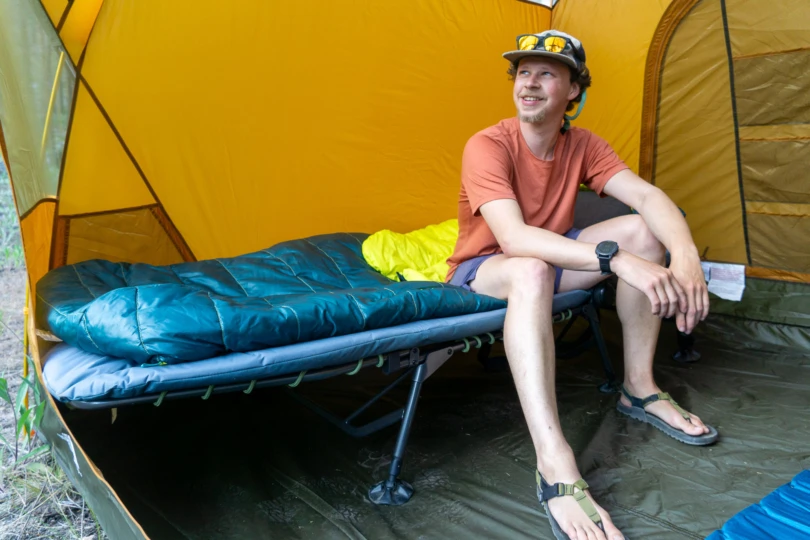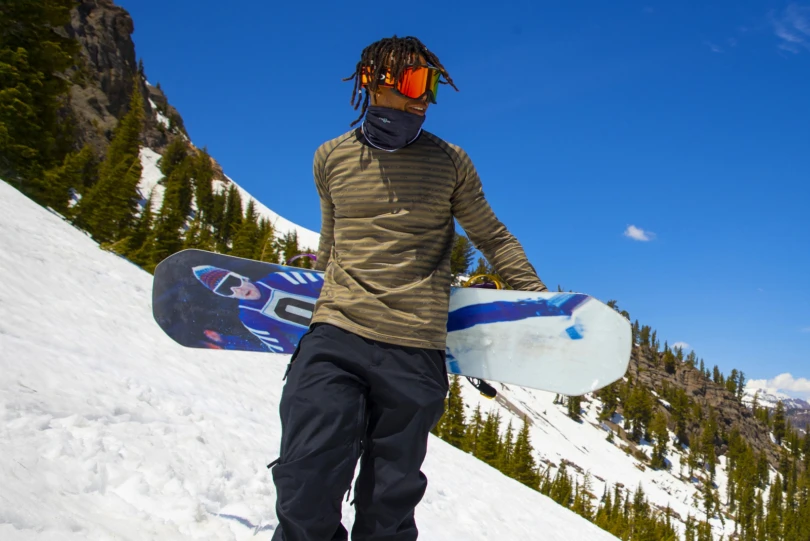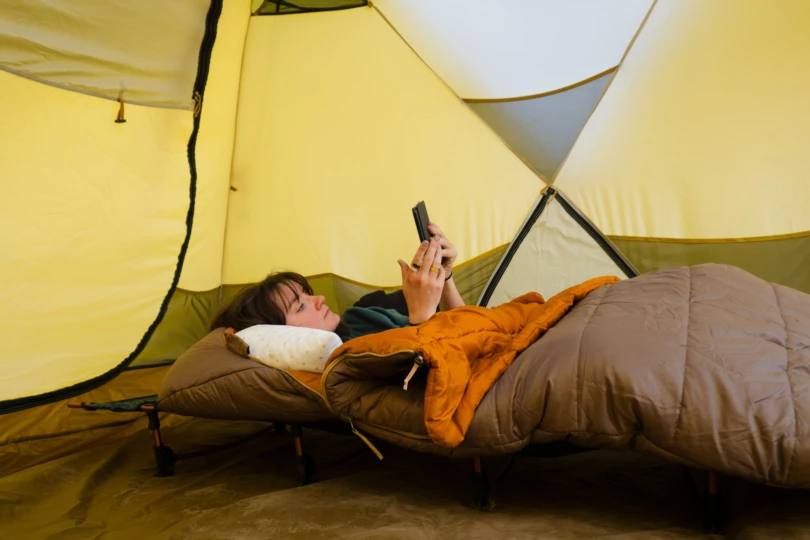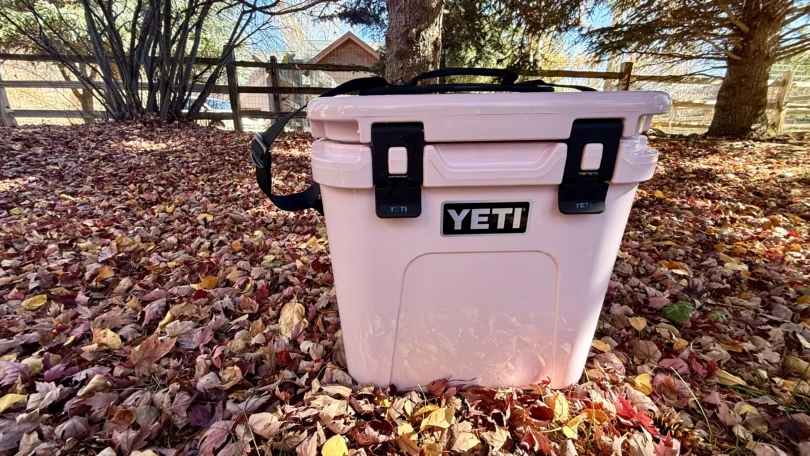Whether you’re out on a solo car-camping adventure, making fireside meals with friends, or relaxing in your hammock, the best camping string lights make the mood what you want it to be. Our experts have been testing camp lighting for close to a decade, and we’ve strung up just about every option on the market and settled on eight of the best for every occasion.
A long string of twinkle lights like the BioLite Luci 44′ Solar String Lights — our top pick — can really brighten the mood wherever you use them, and even a budget-friendly option like the ENO Twilights Camp Lights can perk up the interior of a tent or car camping situation. Moreso than camping lanterns or headlamps, string lights are easy to set and forget and can run long into the evening.
For this roundup, we toted these string lights from the frontcountry to the backcountry, stringing them up in national parks and remote outposts alike. We illuminated our rigs while overlanding, and cast light on camp kitchens to whittle down what exactly makes a good string light. We focused on functional differences in brightness, battery life, durability, and weight, and each light passed through the gauntlet of our unique testing regimen.
Editor’s Note: We updated our Camping String Lights guide on March 10, 2025, to add the soft glow of our new favorite fairy lights, the Revel Gear Trail Hounds, as well as the BioLite Luci Site Lights as our most versatile option.
The Best Camping String Lights of 2026
BioLite Luci 44′ Solar String Lights
-
Brightness
7.0
-
Battery Life
7.0
-
Features
6.0
-
Durability
7.0
- Lumens: 140 lm max; 20 lm low
- Power source: 4,000 mAh Li-ion rechargeable battery, solar panel
- Burn time: 40 hrs. on low; 8 hrs. on high
- Water resistance: IPX4 water resistant
- Weight: 1 lb., 10.2 oz.
- Length: 44'
- USB port: USB-C in; USB-C and USB-A out
Pros
- Ability to light up a broad area, focus on specific zones
- String lights store on the lantern, limiting tangles
- Detachable power hub powers your electronics with USB-A and USB-C ports
- Warm light tone is softer on the eyes
Cons
- The solar panel is small, and the charging capacity is limited
- Take care not to snag the lights, as the wiring can break
ENO Twilights Camp Lights
- Lumens: Not provided
- Power Source: Three AAA Batteries
- Burn Time: 72 hrs
- Water Resistance: IPX4 rated (resistant to splashes)
- Weight: 3 oz.
- Length: 10'
Pros
- Variety of light modes
- Long battery life on three AAAs
- Packable in included soft bag
- Easy to hang
Cons
- Gets tangled easily
- Not rechargeable
- Damageable
Revel Gear Trail Hound 30 Ft. Camping Light
- Lumens: 350 (across the entire string)
- Power Source: USB (5V), optional power pack
- Burn Time: Dependent on power source
- Water Resistance: Waterproof up to USB connection
- Weight: 1.6 oz.
Pros
- Warm color
- Dimmable
- Low power draw
- Packable
- Easy to hang
Cons
- Gets tangled easily
- Requires power source
- Damageable
BioLite Luci Site Lights
- Lumens: Not specified
- Power source: Solar or USB
- Burn time: 20 hrs. on low, 6 hrs. on high
- Length: Adjustable
- Water resistance: IPX4 (resistant to splashes)
- Weight: 1 lb., 1.6 oz.
Pros
- Versatile use as string and ground lights
- Solar and USB charging options
- Sturdy, contained case
- Dimmable
Cons
- Expensive
- Cool white light tone
- Heavy
Nite Ize Radiant Rechargeable ShineLine
- Lumens: Not provided
- Power Source: Rechargeable battery, USB charger compatible
- Burn Time: 6 hrs
- Water Resistance: Not rated, but resistant to light rain
- Weight: 4.2 oz.
- Length: 10'
Pros
- Versatile corded design
- Rechargeable via Micro-USB
- Easy to hang and store with Nite Ize Gear Ties
- Durable with no cord to kink or break
Cons
- Short battery life
- Not consistently bright, or the brightest overall
Front Runner LED Light Strip
- Lumens: 1,600 lms
- Power Source: USB power source
- Burn Time: Dependent on battery source
- Water Resistance: Water-repellant LED case with waterproof connectors
- Weight: 12 oz.
- Length: 4'
Pros
- Impressively bright lighting
- Sized perfectly to fit beneath an awning or inside a rooftop tent
- Durable LED casing and waterproof cord connectors
- Powered from more universal USB, instead of cigarette port
- Dimmer switch
Cons
- Pricey for the length
- Cannot change the light temperature
Brightech Ambiance Pro Solar String Lights
- Lumens: N/A
- Power Source: Solar panel
- Burn Time: 6+ hours
- Water Resistance: Water resistant
- Weight: 1 lb., 15 oz.
- Length: 27'; 48'
Pros
- Ample light for cooking
- Fun, retro look
- Exceptionally warm light temperature
- Solar charging
- Long lasting
Cons
- Bulky
- Cable is messy to store
- Easy to neglect on/off switch
Other String Lights We Recommend
- Lumens: Not provided
- Power Source: Three AAA batteries or USB
- Burn Time: Not provided
- Water Resistance: Not rated, but resistant to light rain
- Weight: 2 oz.
- Length: 8.5'
Pros
- Diffusing carry bag creates a simple lantern
- Multiple power options with USB port
- Ripstop fabric string cover protects delicate wiring
- Integrates with certain Big Agnes tents
Cons
- Hanging clips don't like to stay where they're put
- Bit short for some campsite needs
- Included AAA battery case is liable to break
- Lumens: 110 lms (high), 30 lms (low)
- Power Source: USB
- Burn Time: Dependent on battery source
- Water Resistance: Not rated
- Weight: 1 lb., 8 oz.
- Length: 16'
Pros
- USB power greatly extends run time
- Ability to add more lights
- Adjustable brightness and shades
- Color light options
Cons
- Brightness not adjustable as a group
- Expensive
- Cluttered set-up
Camping String Lights Comparison Chart
| Camping String Lights | Price | Lumens | Burn Time | Water Resistance | Weight |
|---|---|---|---|---|---|
| BioLite Luci 44′ Solar String Lights | $80 | 140 lm max; 20 lm low | 40 hrs. on low; 8 hrs. on high | IPX4 | 1 lb., 10.2 oz. |
| ENO Twilights Camp Lights | $25 | Not provided | 72 hrs | IPX4 | 3 oz. |
| Revel Gear Trail Hound 30 Ft. Camping Light | $25 | 350 (across the entire string) | Dependent on battery source | Not rated, but resistant to light rain | 1.6 oz. |
| BioLite Luci Site Lights | $80 | Not provided | 20 hours on low; 6 hours on high | IPX4 | 1 lb., 1.6 oz. |
| Nite Ize Radiant Rechargeable ShineLine | $30 | Not provided | 6 hrs | Not rated, but resistant to light rain | 4.2 oz. |
| Front Runner LED Light Strip | $60 | 1,600 lms | Dependent on battery source | Water resistant | 12 oz. |
| Brightech Ambiance Pro Solar String Lights | $45 | Not provided | 6+ hours | Not rated, but resistant to light rain | 1 lb., 15 oz. |
| Big Agnes mtnGLO Tent Camp Lights | $35 | Not provided | Dependent on battery source | Not rated, but resistant to light rain | 2 oz. |
| GoalZero Light-A-Life Mini | $80 | 110 lms (high), 30 lms (low) | Dependent on battery source | Not rated | 1 lb., 8 oz. |
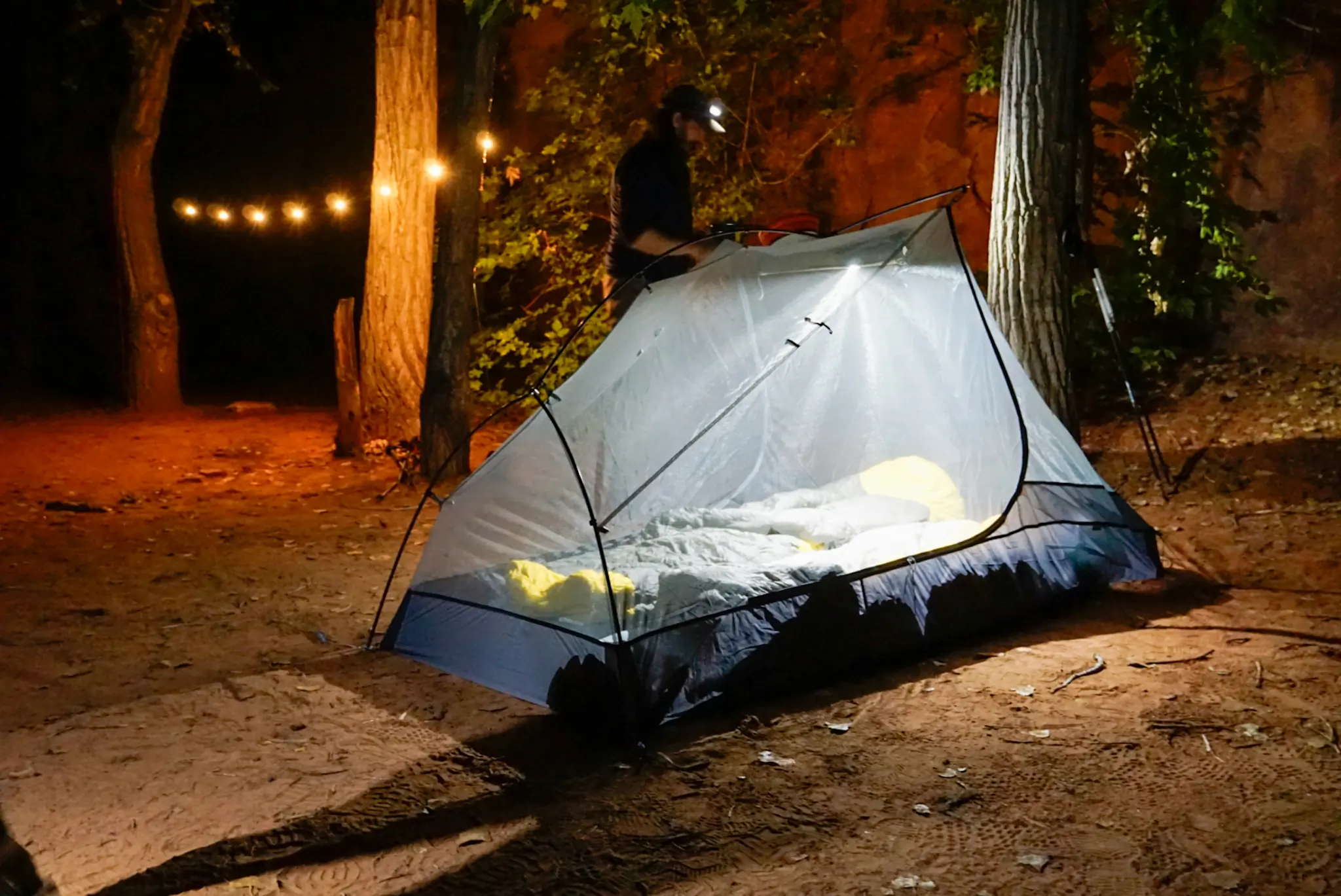
How We Tested the Best Camping String Lights
Camping string lights are pretty simple, but that didn’t stop us from diving in and trying to separate the excellent from the just alright. Our selection process begins by word of mouth or through deep research to key in on a slate of worthy testers. From there, it’s into the hills.
Our camp testing of these string lights has taken us far and wide, and they’ve lit the way to front country campsites across the West — from dim ocean-side camps in the Hoh Rain Forest to alpine lakes in the Colorado high country. Our experts cover the spread from mobile-working van lifers to itinerant dirtbags, and each has strung up a light or three to see what they’ve got to offer.
Our Testing Process and Testing Grounds
The weather isn’t always going to cooperate for your weekend shindigs, and our rain test occurs during real, day-long Pacific Northwest rain storms. After spending the day in the rain, each light is turned on and inspected for any damage. The battery test, too, sought to challenge these string lights with real-life usage, and included charging rechargeable lights fully, setting up battery-powered lights with brand new batteries, and hooking up plug-in lights with portable batteries, then running each light until they died.
The “big campsite” test assessed each light’s ability to light up a large campsite on its own. We were able to see if a light was bright or long enough to light up the common space where food and drinks were being made. The lights that weren’t suited for whole campsites were set up in tents, backs of cars, and over hammocks to see if they worked better for a single camper.
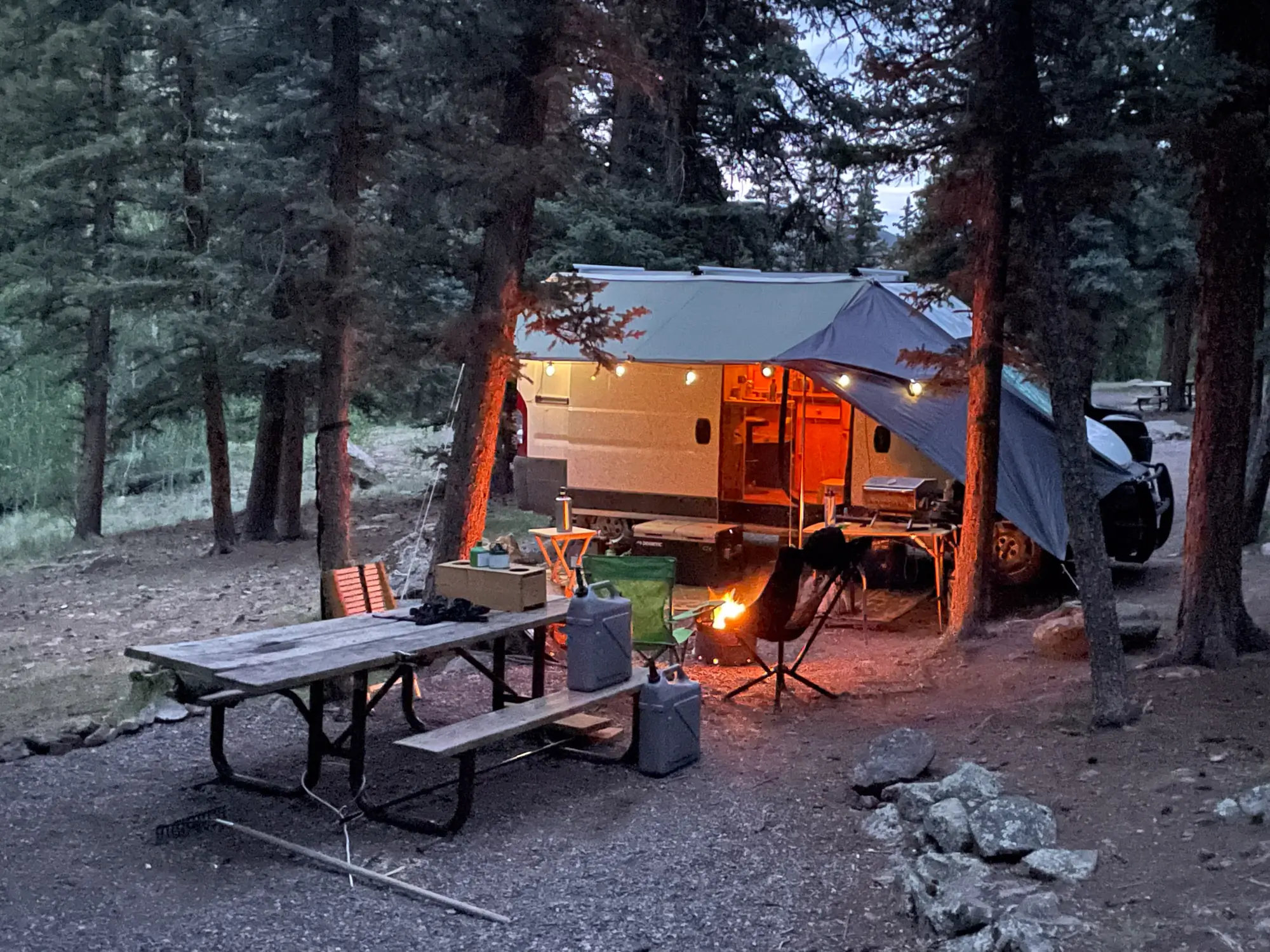



Our testing didn’t stop when we rolled up the sleeping bags, either. Over a handful of seasons here, we’ve pulled together a set of bench tests to really challenge string lights and ensure they don’t leave you hanging when you need them the most.
The first challenges string light’s particular capacity for turning into tangled spaghetti when absent-mindedly packed away, and during our so-called ‘stuff test,’ we packed away each of these lights both loosely and in any included storage bag. This test aims to determine how easy these lights were to pack and unpack, as well as how likely they were to tangle or break inside a pack.
In addition, the durability test involved some good old-fashioned muscle power, and saw our testers pulling, stretching, and yanking on these lights to see if they would break under abuse. Though this test might have been more aggressive than what these lights would see in their normal use, it not only determined each light’s general durability, but where a user might see wear and tear over time.
Our Expert Testers
Our lead tester Maddie Downie is an experienced camper, hiker, hammocker, and fireside hang-outer based in Washington State. She grew up camping with her family in the Colorado backwoods, and now spends almost every weekend night out of the summer sleeping outdoors.
Maddie understands the difference between setting up a camp for an early start the next day and putting together a campsite for friends to gather for drinks, and tested each light with this context in mind, developing a few specific tests to put these lights through: a stuff test, rain test, battery test, “big campsite” test, and durability test.
One of our other main testers, Karuna Eberl has spent decades backpacking, tent camping, and van-life-ing around the West and Baja, down to the Florida Keys, and around Europe. She also has a background in filmmaking, which adds to her persnicketiness about using lighting to create a feel-good mood.
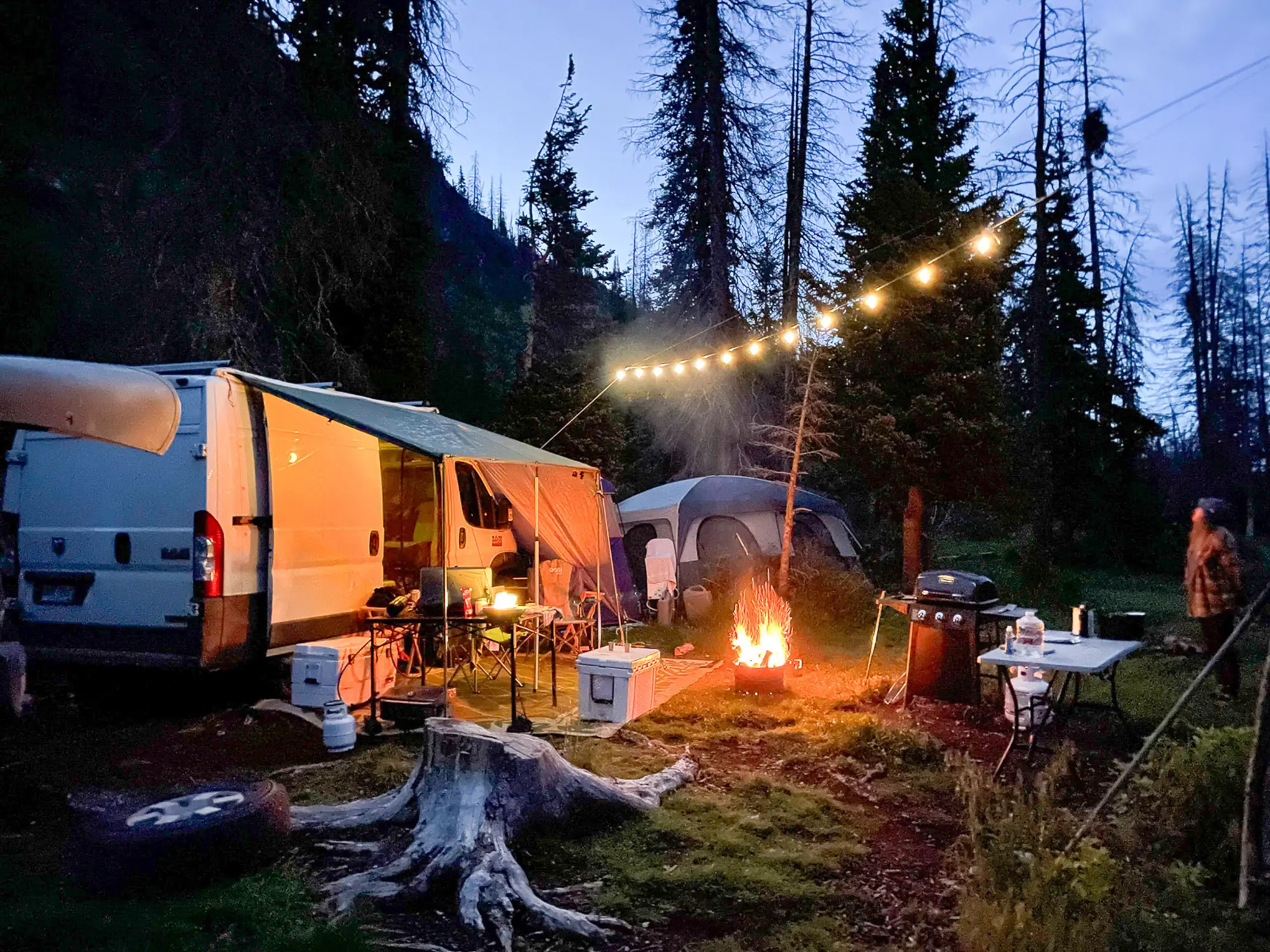



Buyer’s Guide: How to Buy Camping String Lights
We set out to find the best camping string lights on the market to give you the best recommendations for your adventures. It’s important to note, also, that string lights oftentimes will be accessories to other camp lighting solutions, such as Camping Lanterns or a good Headlamp.
Consider all of these to form a system that covers your campsite with light: headlamps for detail work like chopping veggies or zipping up a tent, lanterns for gathering around and telling stories, and string lights to guide your way around the party. Here’s what we’ve found to be the most important considerations when purchasing camping string lights:
Power Source
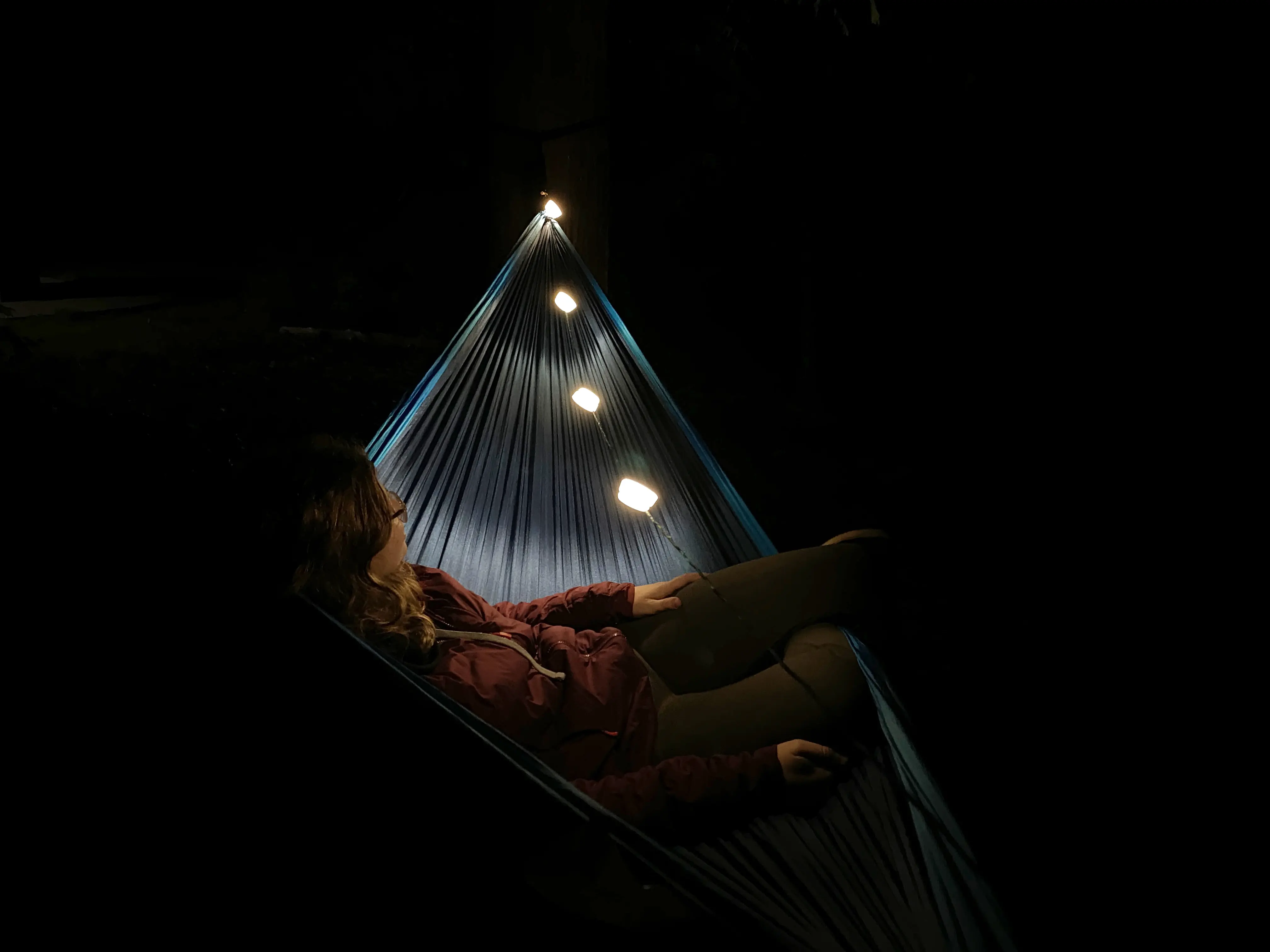



Before you can have light, you need power. String lights have a few different means of power, and what will work best for you depends on how you plan to use your lights.
Built-in Battery
For optimal portability, having a set of string lights with a built-in battery will allow you to bring light anywhere without further complications. These lights have the benefit of not needing anything else to work, but that means they’re another thing you’ll have to remember to charge before heading out for the weekend.
If you have the space, you can pack a portable battery as well. While these lights are easy to bring along, they typically don’t have long battery life, lasting for an average of less than 10 hours. For instance, the Nite Ize Radiant ShineLines take about an hour and a half to charge completely for a 6-hour battery life.
Replaceable Battery
Battery-powered lights are also portable, but keep in mind that these batteries can weigh down your pack. It also means you have to remember to put in fresh ones before heading out or running the risk of running out of power. Having rechargeable batteries for these lights will save you money!
These lights will generally last longer than the built-in battery lights, anywhere from three days to a few weeks, depending on how much you’re using them. It’s most likely a string light with a replaceable battery will take AA or AAA batteries, such as the ENO Twilights that take three AAA batteries.
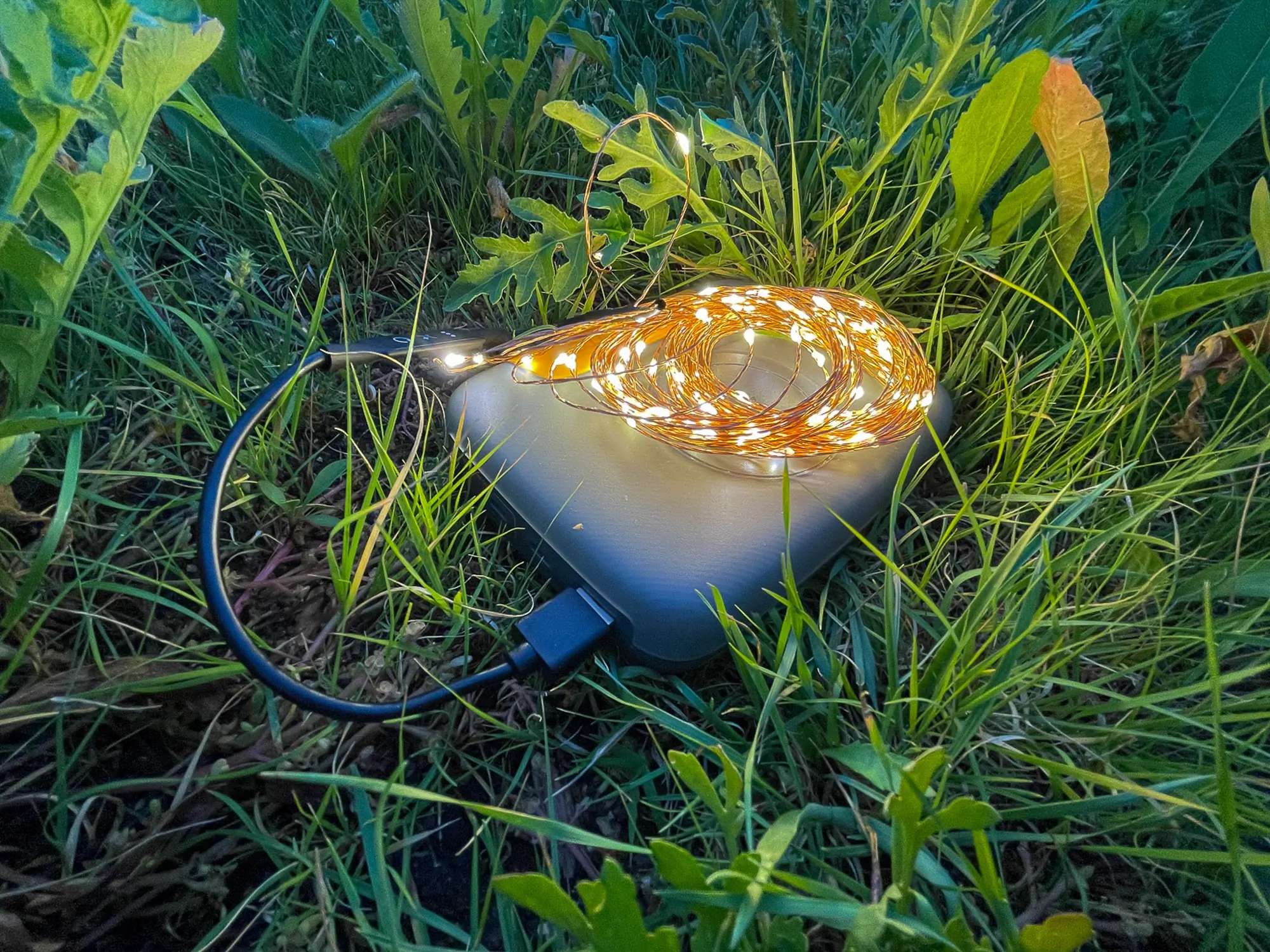



Plug-In
Lights that require a plug-in to work may be better suited for car camping, boondocking, or lighting up an outdoor space at your home. Plug-in lights can come in a variety of types, such as USB or outlet plug-ins.
Keep in mind that not all USB cords are the same; lights may come in USB-C, USB-A, or Micro-USB. USB plug-ins are the most portable as long as you don’t mind packing a battery bank. And some USB plug-in lights are compatible with lanterns, such as the Revel Gear Trail Hounds.
However, lights that require being plugged into a wall outlet are better suited for RV camping or lighting up your back porch. These lights are a great choice for car camping in cars that have USB or house-plug converters, or when you’re bringing along a portable power station. Plug-in lights also mean you can run these lights longer. House plug-in lights last as long as you want and USBs last as long as your battery bank can.


String Light Size
Some string lights are for small areas, like the back of a pickup truck, while others will light up your whole campsite. String lights that emphasize portability are generally better for smaller campsites as they are dimmer and smaller. These lights range anywhere from one foot to 10 feet in length. Shorter ones are better for lighting up the inside of your car or tent, or illuminating your hammock.
Lights that require being plugged in are better suited for large areas as they are generally larger and brighter. These lights can range from a few feet to several yards, and can stay brighter for longer. But we didn’t include any in this guide, since there are also lights suited for larger areas that don’t require an outlet, like the Brightech Ambiance Pro Solar String Lights, which are 27 feet long with 12 LED bulbs. We use these with our van camping setup, plus have installed them over our back deck, even though there are outlets available.
Brightness
The brightness of a light is also dependent on its power source, as well as the type of light. LEDs are the most common because they work really well and are power efficient. LED lights that run off a rechargeable or battery-powered source (including solar) are often not as large or bright as plug-in lights. This makes them better suited for lighting up small spaces such as a car or tent. Some, like the Revel Gear Trail Hounds or ENO Twilights Camp Lights, are particularly suited for backpacking, being very lightweight and compact. However, these types of lights may also dim as the battery dies.
Plug-in lights are brighter from 100 lumens (lms) to 1,000 lms. The Front Runner LED Light Strip comes in at 1,600 lms! Plug-in lights also stay brighter for longer and are less likely to dim as you use them.
Some camping lights use alternative light sources, such as the fiber optic lights in the Nite Ize Radiant ShineLines. These lights are generally not as consistently bright as LED lights, and offer more of a glow than a shine. The fiber optic design means that the light isn’t consistently bright through the cord, but is brighter the more it is bent.




Light Spectrum and Color
Some lights give off a warm glow, like a campfire, while others are starkly white or even borderline bluish, like the moon. This is called color temperature, and it is measured in degrees of Kelvin. Camping and household lights commonly range from 2,000 to 6,000 degrees. The lower the number, the warmer the tone.
Choosing a color temperature is a matter of personal preference. Generally speaking, warmer tones create happier, more welcoming vibes, whereas cooler temperatures tend to feel utilitarian, even irritating. Cooler tones travel farther, so they’re better for flashlights. Otherwise, warmer tones are still capable of illuminating a cooking area, plus allow your eyes to more quickly readjust to the darkness beyond and are less obnoxious for all of the wild creatures you’re sharing space with (same idea as using a red reading lamp vs. a white one).
If you’re not used to looking at color temperature, you might not even notice it. Many people don’t until it’s brought to their attention. For me, it’s the most important factor when buying a light. There’s a reason movies use lighting to manipulate the mood. It’s the difference in scene between a rom-com, with a cozy cuddle on a beach, and a horror flick, with a lurker creeping up on the camp.
Light Adjustment
Many camping string lights come with light adjustment options which can be helpful in setting a desired mood. Many come with a simple high brightness and low brightness, such as the GoalZero Light-A-Life lights that have a 110-lumen high setting and 30-lumen low setting. This setting is great for transitioning into a sleepier mood.
Other lights have blinking and color-changing effects, which keep the mood more energized. The color ENO Twilights have a setting that will gradually rotate through all of the colors. However, a few lights require that you cycle through these different settings to turn the light off, which can definitely be an annoyance around bedtime. No one likes a strobing light right as they’re about to fall asleep.




Storage
There are a few factors to consider when thinking about storage of your camping string lights, which can be dependent on the type of camping you want to do. For backpacking or camping where a portable light is necessary, having a specific storage container is nice.
Several battery-powered or rechargeable lights, such as the ENO Twilights, come with a soft storage bag that fits nicely inside a pack. Some lights, such as the Nite Ize Radiant ShineLines come with gear ties that make it easy to loop these lights up and tie all ends together. Lights without a specific storage method require a little creativity to store and run the risk of getting tangled or damaged.
Even if a light comes with a specific storage container, the ease of setting them up and putting them away is a consideration. Soft storage bags are generally easy to stuff lights into, and ties take a bit longer to put away. The BioLite Luci Site Lights may win the award for easiest to store as the lights are stored in a magnetized case.
Despite how easy each light is to store, there is always the risk of lights getting tangled in storage. We found that string lights that can be stored in a soft bag are easy to get tangled, which adds more time to setting up your campsite. Lights that are stored with ties are less likely to get tangled. Spending the time to fold or wrap your lights carefully will prevent tangling and make your future self a happier camper.
Proper storage can also prevent wear and tear. Lights with rubber or plastic wire coverings have a higher chance of tearing, stretching, or breaking, so it’s especially important to store these lights with care. We found that lights that are shoved into bags or that are just tossed loosely into packs are more likely to experience this kind of wear. Even if a light doesn’t come with a specific storage container, creating one out of a plastic bag or with wire ties could save you from having to replace them right away.
Hanging Functionality
The types of hanging features on a string light can determine how easy they are to set up at a campsite. Many string lights come with hooks that can be used to clip the lights to tent poles, hammocks, or the inside of your car. The BioLite SiteLights come with small hooks on either end that make it easy to attach these lights to different parts of a campsite.
The Nite Ize ShineLines might take the cake for hanging features. Not only are these lights easy to wrap around objects, but they come with four rubber-covered hanging wires that can be used to attach these lights to almost anything. The attachments are super malleable and can be moved anywhere on the light where they are best fit. They also make it easy to store these lights as you can tie off the lights when they are bundled.
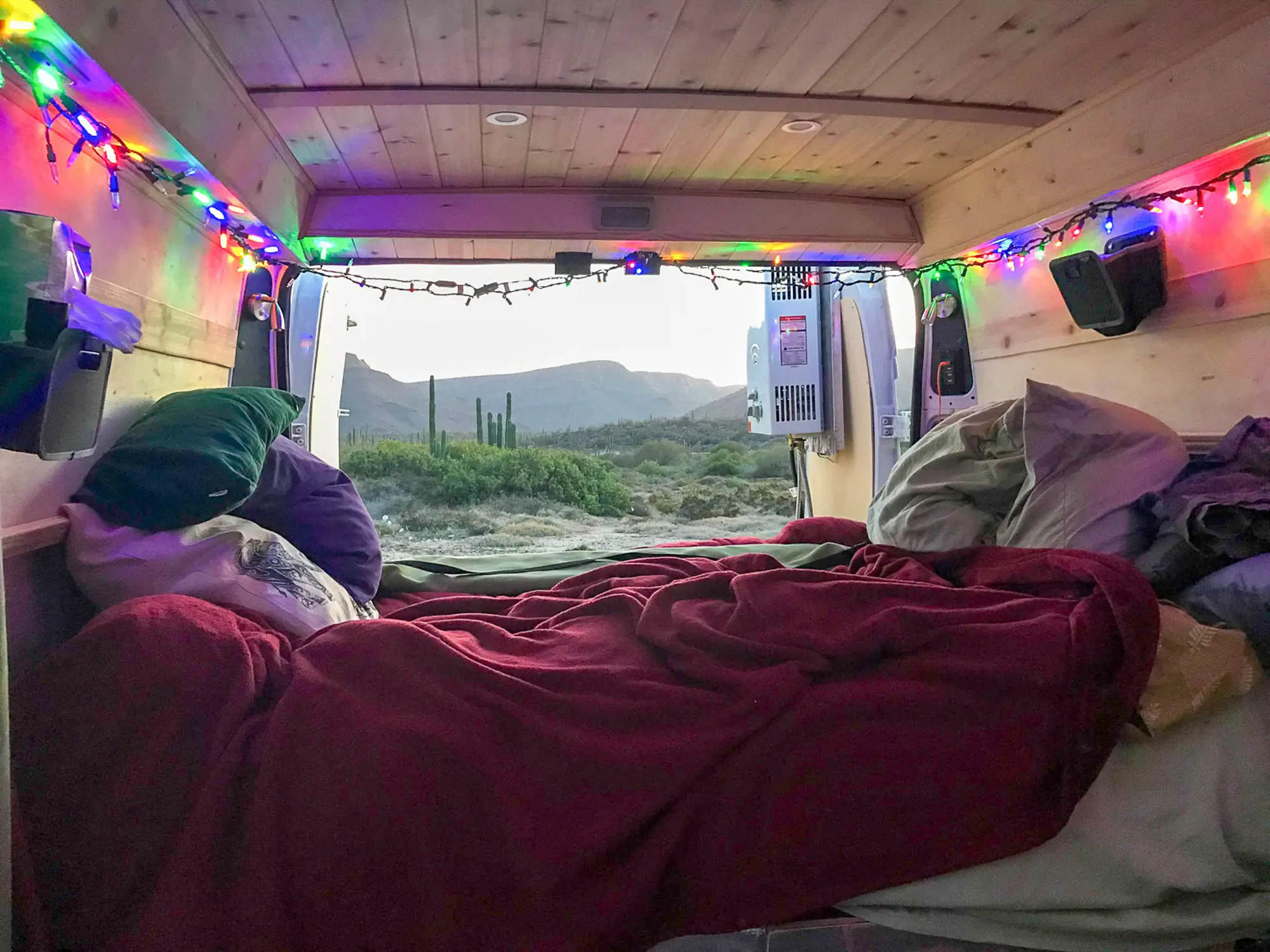



Durability and Water Resistance
When choosing between camping lights, the durability of those lights should be a consideration. As a whole, companies designing outdoor lights have put effort into making them durable, such as concealing the lights and wires themselves in some protective material. The ENO Twilights are almost completely plastic-covered, which keeps dust and water at bay for the most part. However, over time, the plastic seems prone to stretch and tear if these lights are handled roughly.
Plug-in lights that come with exposed components should be handled and stored with extra care. For instance, the Revel Gear Trail Hounds come with a USB dongle that could be damaged if left in the dirt and rain. The Nite Ize ShineLines have a plastic cover that should be used to keep dirt out of the charging port on the end of the light.
Many of these outdoor string lights are water-resistant and IP-rated. The IP scale refers to how water-resistant something is, and the definitions of each rating are easy to look up online. In general, most string lights seem to be resistant to splashes, but aren’t likely to make it if dunked in water. The Front Runner LED Light Strip is IP65 rated, meaning it’s resistant against “jets” of water. Still, it’s best to assume that no string light is waterproof and try to keep your lights out of the rain as much as possible.
Price & Value
Camping string lights aren’t typically the priciest thing you’ll splurge on for your camping kit, but as consumer electronics, there is a pretty wide spread in terms of price and in turn quality. Cheap string lights tend to burn out prematurely, so it’s good to invest in something that is going to last, and provide the ambiance you’re going for.
Budget
Even budget string lights can be excellent (or pick, the ENO Twilights Camp Lights, are only $25), but there are a few things you’ll likely leave on the table for spending bottom dollar. For one, budget options tend to be powered by traditional AA or AAA cells. This isn’t a hard and fast rule, but you’ll be hard-pressed to find integrated batteries in a cheaper set. Overall brightness might also be a little less, and make these lights better suited for use inside of tents compared to across entire campsites.
Mid-Tier
Spending $40-60 for a set of string lights means they’ll almost always be brighter, longer, and potentially adjustable. This can come in the form of dimmability or the addition of different light modes, such as a twinkle or pulse effect. Increased durability will also come with the increase in price, with better water resistant ratings, as well as more protected cords that might be covered in rubber or textile sleeves.
The Brightech Ambiance Pro Solar String Lights ($45) get you a lot for the money, and while they’re better suited for RV boondockers, you do get a built-in solar panel to power the lights, meaning you’ve got true off-grid ability. The Front Runner LED Light Strip ($60) is similarly suited for vanlifers but is a bit more functionally rich with a dimmable switch as well as a robust sleeve for the LED strip and multiple mounting options.
Premium
Premium string lights are going to offer up even more versaility, and the BioLite Luci 44′ Solar String Lights ($80) integrates a built-in solar panel, as well as an on-board battery bank that can even charge your phone. The extended length is also typical of the price range, and a full 44 feet can illuminate even the biggest campsites.
Frequently Asked Questions
The most convenient light will depend on what you need to do with your light. Are you walking and exploring in the dark? Then you’ll want something like a headlamp or flashlight you can use to direct a beam of light ahead of you and down the trail.
Do you have a central area like a table or tent you need to light? Then the expansive glow of a lantern might be what you’re looking for. If you’re trying to light up a large, spread-out area, string lights are likely your best bet as they can extend over a large area. And if you want brighter light, you can simply wrap them, or even pile them, in a more central location.
The length of time your lights can stay on will depend on how bright you have them set and how powerful the battery is. Sometimes the power source is built into the lights, but others can be plugged into an external power bank. The bigger the bank, the longer the lights will last.
Still, with most high-efficiency LED lights used in these products, you can expect your lights (like the ENO Twilights) to last for at least several hours. If you use a lower-power setting, some string lights can even last for days at a time, and features like built-in solar panels on the BioLite Luci Solar String Lights will only extend this time.
The number of lights you need is entirely dependent on how big your campsite is and how bright you want it to be. For brightness, consider whether you want a single string light that crosses a campsite for some added ambiance, or if you want to crisscross string lights across your campsite to provide illumination.
Some brands offer long strings with dozens of lights (like the Brightech Ambiance Pro Solar String Lights). However, you may actually be better off opting for smaller sections of lights you can string together. Just remember, the more you string together, the faster the battery drains.
Don’t be afraid to get creative and experiment to find the lighting you prefer.
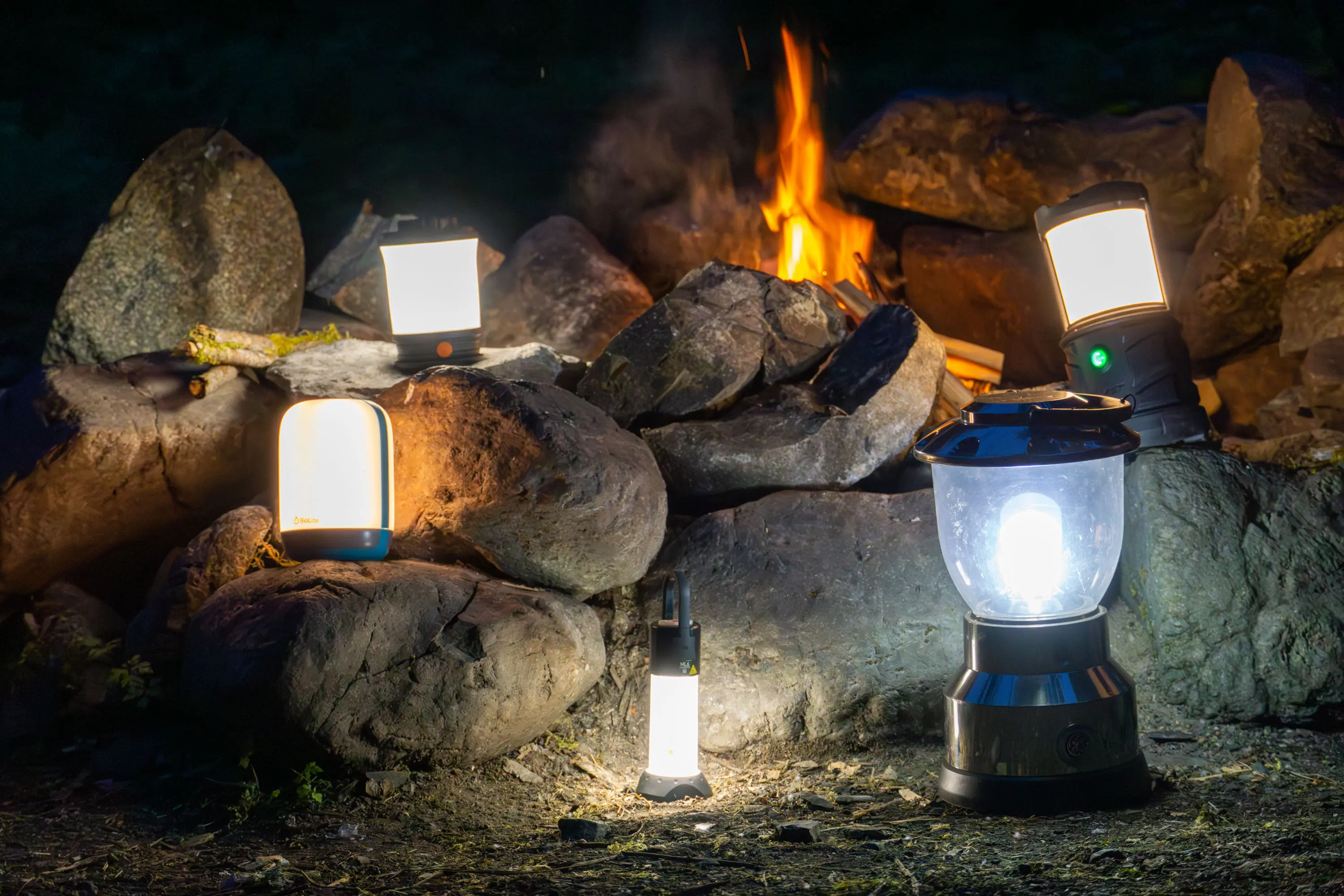

The Best Camping Lanterns of 2026
Whether heading into the backcountry or lighting up the night while car camping, we’ve found the best camping lanterns for every use and budget. Check out our top picks from BioLite, Goal Zero, Fenix, and more.


The Best Headlamps of 2025
We tested the best headlamps of 2025 with options for every budget. Top picks include BioLite, Black Diamond, and more!
